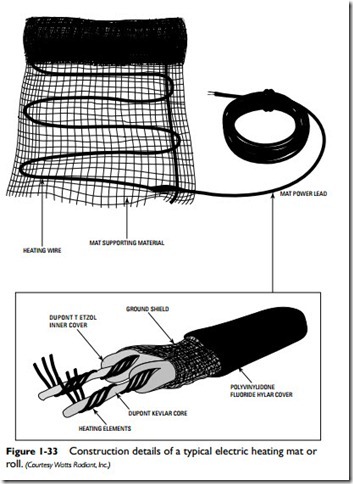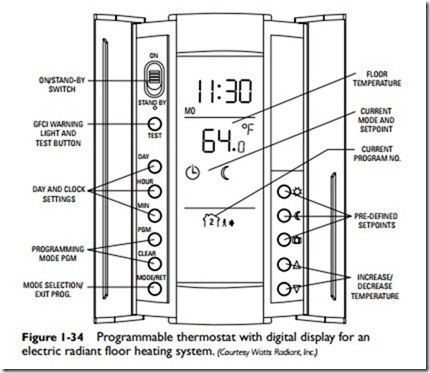Electric Radiant Floor Heating
A number of manufacturers produce electric radiant floor heating systems for use in residential and light commercial construction. They are safe, relatively easy to install, and extremely energy efficient.
Note
Electric radiant heating produces electromagnetic fields, and these EMFs may cause health problems. The potential health risk from EMFs can be minimized or even eliminated by (1) following the wiring and grounding methods recommended by the National Electrical Code; (2) purchasing and installing a radiant heating system that produces very low EMFs (some manufacturers claim zero EMFs for their systems); and (3) avoiding systems that produce EMFs higher than 2 mG at 2 feet.
Most of these electric radiant floor heating systems consist of a thin electric mat or roll applied to the subfloor where it is embedded in a thinset or self-leveling cement. Watts Radiant manufactures heating mats (HeatWeave UnderFloor mats) for installation between the floor joists under the subfloor.
System Components
An electric floor heating system in which electric heating mats or rolls are used will include some or all of the following components, depending on the system design:
1. Heating mats or rolls
2. Thermostat
3. Floor sensor
4. Ground fault circuit interrupter
5. Relay contactor
6. Timer
7. Dimmer switch
Heating Mats or Rolls
The electric mats or rolls used in electric floor radiant heating systems are made of coils of heat resistance wire joined to a supporting material. They are only 1⁄8 inch thick, which means they can be installed over the subfloor and under the floor covering without significantly raising the floor level (see Figure 1-33). The heating element of a constant-wattage electric heating cable or wire operates on 120 volts or 240 volts.
Electric heating mats or rolls are produced in a wide variety of sizes to fit different floor dimensions. Custom sizes can also be ordered from manufacturers to fit areas with curves, angles, and other nonstandard shapes.
An entire electric radiant floor heating system can be ordered from any one of the manufacturers listed in the sidebar. When ordering the materials for one of these heating systems, send them an installation layout plan listing the exact dimensions of the rooms or spaces to be heated. The plan may be for an entire house, an addition to a house, or a single room or space.
Note
The manufacturer will cut the mats or rolls to the sizes listed in the installation plan. Once the mats or rolls are cut, they cannot be returned if a mistake is discovered unless it can be shown that the manufacturer was at fault.
Automatic Controls
The automatic controls of a typical electric radiant floor heating system consist of a thermostat, a GFCI safety breaker, and an optional timer. If a floor-heating thermostat is used instead of a room thermostat, the former is wired to a floor sensor that detects the actual floor temperature. A GFCI and a timer are integral components of a floor-warming thermostat.
Thermostat
The thermostat is the controlling device for an electric radiant floor heating system. Most modern systems use a programmable thermostat, which contains an integral ground fault circuit interrupter (GFCI) and a manual high-low temperature setback switch
(see Figure 1-34). A programmable thermostat is connected to an embedded floor sensor that monitors the floor temperature and transmits it to a digital display on the thermostat. A programmable thermo- stat can be programmed for four setting changes each day of the week.
Nonprogrammable thermostats are used commonly for small spot-warming areas. They are also equipped with a GFCI device.
Note
Never exceed the maximum capacity of the thermostat to heat the floor. If additional power is required, zone with additional pro- grammable thermostats or use a relay contactor.
Floor Sensor
A floor sensor is a temperature-monitoring device embedded in the floor and connected to a programmable thermostat. It should be installed in such a way as to give the truest floor temperature. Its installation will also be governed by the type of floor covering.
Many manufacturers will recommend the location of the floor sensor for the different types of floor coverings used with their floor sensor (see Figure 1-35).
Ground Fault Circuit Interrupter
A ground fault circuit interrupter (GFCI) is used to monitor the flow of electricity through the heat resistance wire in the mat or roll for any loss of current. If a loss of current is detected, the GFCI immediately cuts off the electricity to the heating system. This is done to prevent damage to the heat resistance wire in the heating mat or roll. The GFCI is an integral part of a programmable thermostat.
An indicating-type GFCI circuit breaker may be installed to serve as a local disconnect. It should be installed near the end of the line close to the thermostat.
Relay Contactor
A relay contactor is a device used in conjunction with a single controller to operate the heating in large rooms or spaces. Both single- and double-relay contactors are used in heating systems.
Timer
A timer is an optional device used to control when the heating sys- tem is turned on and off. It can be used to program 14 events, or two on-off cycles per day for a 2-day or 5-day period. It also can be used in conjunction with a dimmer switch to regulate floor temperature. It cannot moderate the floor temperature.
Dimmer Switch
A dimmer switch is a device with an on-off button and a sliding manual control used in some systems to increase or decrease the floor temperature. It can be used in conjunction with a 7-day programmable timer to program a weekly period repetitively.




